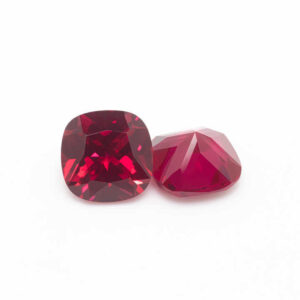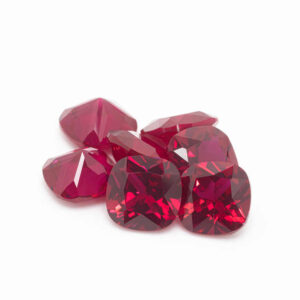Synthetic rubies have become increasingly popular due to their stunning appearance and affordability. However, for gemologists and consumers alike, one key question remains: how can you tell if a ruby is synthetic or natural? The answer lies in subtle scientific techniques. In fact, scientists often add specific elements or leave identifiable marks in synthetic rubies to help distinguish them from natural rubies.
In this article, we’ll explore how synthetic rubies are made, what scientists add to them for identification, and how experts can tell them apart from their natural counterparts.
🔬 How Are Synthetic Rubies Made?
Synthetic rubies are chemically identical to natural rubies — both are made of aluminum oxide (Al₂O₃) with traces of chromium that give them their rich red color. The main difference lies in how they’re formed.
Common Ruby Synthesis Methods:
- Verneuil Process (Flame Fusion) – The most common and oldest method; fast and cost-effective.
- Flux Growth – Slower and more expensive, produces more natural-looking gems.
- Hydrothermal Growth – Uses high pressure and temperature; mimics natural conditions.
🧪 What Do Scientists Add to Synthetic Rubies for Identification?
To ensure transparency in the gem trade, scientists and manufacturers may intentionally add certain substances or design growth markers in synthetic rubies to make them identifiable.
1. Trace Elements or Dopants
Certain trace elements may be added during the growth process that are not commonly found in natural rubies:
- Lead (Pb) – May be present in some flame-fusion rubies.
- Bismuth (Bi) or Thorium (Th) – Rare elements sometimes added for identification.
- Calcium or Nickel – Occasionally used as growth stabilizers and leave a signature trace.
2. Growth Features Unique to Synthetic Rubies
Manufacturing methods often create distinct internal patterns:
- Curved Striae (Curved Growth Lines) – Seen in flame-fusion rubies; natural rubies exhibit angular or intersecting growth lines.
- Gas Bubbles – Small round gas bubbles may be trapped in synthetic rubies — a by-product of fast growth, not found in natural rubies.
- Flux Inclusions – In flux-grown rubies, residual flux material can be seen under magnification — a clear indicator of artificial origin.
3. Fluorescence Markers
Scientists may use UV-reactive elements to create distinctive fluorescence patterns in synthetic rubies. These patterns are often not present in natural stones and can be observed under ultraviolet light.
💡 Why Add These Identifiers to Synthetic Rubies?
- ✅ Transparency & Ethical Practices – Consumers deserve to know what they’re buying.
- ✅ Prevent Fraud – Helps prevent synthetic rubies from being misrepresented as natural.
- ✅ Ease of Identification – Aids gemologists and customs officials in quick authentication.
🔍 How Can You Tell If a Ruby Is Synthetic?
While some synthetic rubies are easy to identify with the naked eye or a loupe, others require gemological testing such as:
- Microscopic analysis
- UV fluorescence testing
- Spectroscopy
- Refractive index and specific gravity measurement
A certified gemologist or lab report is the most reliable way to confirm a ruby’s origin.
📌 Conclusion
What do scientists add to synthetic ruby to distinguish it? The answer lies in a combination of trace elements, structural features, and fluorescence markers — all designed to make synthetic rubies detectable under professional examination.
If you’re buying a ruby — especially an expensive one — make sure it comes with a lab certificate that indicates whether it’s natural or synthetic. Transparency and education are key to enjoying the beauty of rubies with confidence.
💎 Frequently Asked Questions (FAQ)
Q: Are synthetic rubies real rubies?
A: Yes, synthetic rubies are chemically identical to natural rubies. The only difference lies in their origin and formation process.
Q: Can jewelers tell if a ruby is synthetic?
A: Professional jewelers with the right tools or certification can often identify synthetic rubies through microscopic inspection or lab testing.
Q: Are synthetic rubies less valuable?
A: Generally, yes. Synthetic rubies are more affordable than natural ones due to their abundance and lower production cost.







